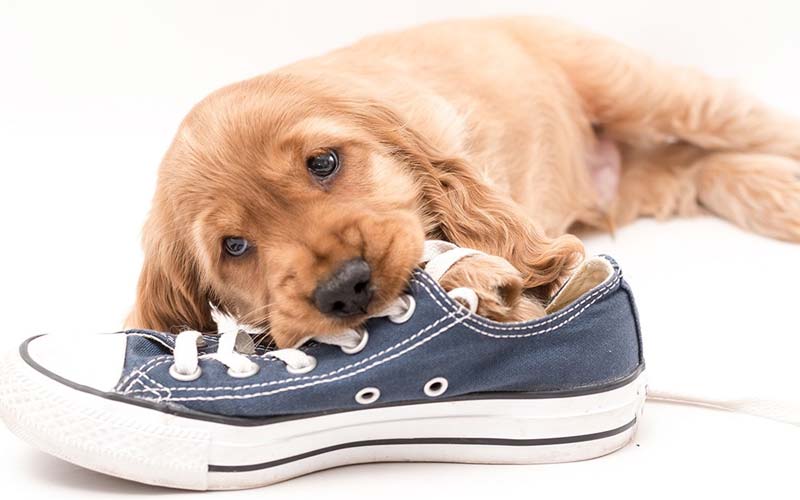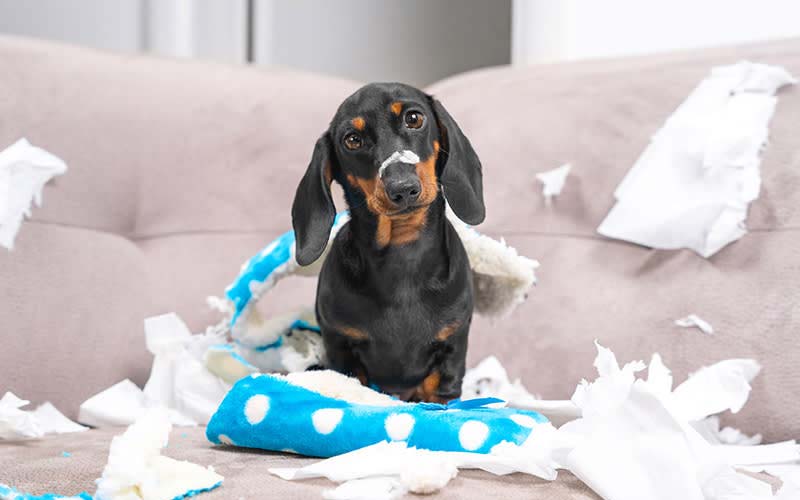Destructive chewing can be one of the most frustrating behaviors for dog owners. From chewed-up furniture to destroyed shoes, this common issue can quickly lead to a damaged home and a strained relationship with your pet. However, it’s important to remember that chewing is a natural and necessary behavior for dogs, especially for puppies who are teething or exploring their environment. The key is learning how to manage and redirect this behavior appropriately.

In this article, we will explore the causes of destructive chewing and provide practical, proven tips to help you stop it. Whether you’re dealing with a teething puppy or an adult dog with behavioral issues, you’ll learn how to protect your belongings while ensuring your dog stays happy, stimulated, and well-behaved.
1. Understanding Why Dogs Chew
Chewing is a natural and instinctive behavior for dogs. It serves a variety of purposes, from exploring their environment to relieving stress. While this behavior is completely normal, it can become destructive if not properly managed. Understanding why your dog chews is the first step in preventing damage to your belongings.
Common Causes of Destructive Chewing:
- Teething in Puppies: Puppies go through a teething phase where chewing helps relieve discomfort as their new teeth come in. This stage can last several months and requires extra attention from owners.
- Boredom or Lack of Stimulation: Dogs, especially high-energy breeds, need both physical and mental stimulation. When bored or under-exercised, they may turn to chewing as a way to pass the time and release pent-up energy.
- Separation Anxiety: Dogs suffering from separation anxiety often chew on household items as a way to cope with the stress of being left alone. This behavior is typically accompanied by other signs of anxiety, such as whining, pacing, or barking.
- Curiosity and Exploration: Young dogs, in particular, explore the world with their mouths. This curiosity can lead to inappropriate chewing as they investigate new objects in their environment.
- Lack of Appropriate Chew Toys: If dogs don’t have the right outlets for their chewing, they will turn to whatever is available, from furniture to shoes. Providing appropriate toys can help redirect this behavior.
By recognizing these triggers, dog owners can begin addressing the root causes of destructive chewing and take proactive steps to prevent it.

2. Steps to Stop Destructive Chewing
1. Provide Proper Chew Toys
One of the most effective ways to prevent destructive chewing is to offer your dog appropriate items to chew. Chewing is a natural behavior, so rather than trying to stop it entirely, it’s important to redirect it to safe, durable toys.
- Importance of Chew Toys: Dogs need an outlet for their chewing instinct, whether they’re puppies teething or adult dogs needing to burn energy. Without proper chew toys, they may turn to household items like shoes, furniture, or clothing.
- Types of Safe Chew Toys: Choose durable toys that match your dog’s size and chewing strength. For puppies, softer, rubber toys like KONGs are ideal. Adult dogs may need tougher options like nylon bones or rope toys. Avoid toys that can break into small, swallowable pieces.
- Introducing New Toys: Keep your dog engaged by rotating toys regularly. Introduce toys by playing with your dog, making the toy a fun and rewarding experience. Add treats inside puzzle toys or KONGs to make them more exciting.
2. Physical and Mental Stimulation
A lack of physical exercise and mental engagement is often the root cause of destructive chewing. Providing enough stimulation helps reduce boredom, anxiety, and pent-up energy.
- Physical Exercise: Ensure your dog gets daily exercise suited to their breed and energy level. Regular walks, play sessions, and interactive games can keep your dog physically tired, reducing their urge to chew.
- Mental Stimulation: Alongside physical activity, dogs need mental challenges to stay occupied. Puzzle toys that require problem-solving or treat-dispensing toys are great for engaging your dog’s mind. Training sessions also provide mental stimulation and can reinforce good behavior.
3. Crate Training and Safe Spaces
Crate training can be a valuable tool in preventing unsupervised chewing, especially when you’re not home. It provides a safe, confined space where your dog can relax without getting into trouble.
- Benefits of Crate Training: When introduced properly, crates become a secure, comforting space for your dog. Using a crate when you’re away limits their access to household items they might chew on. It also helps with anxiety by giving them a designated area to rest.
- Creating a Safe Chewing Area: In addition to crate training, create a dog-friendly area in your home where your dog can be supervised while chewing on appropriate toys. This helps teach them what’s acceptable to chew.
4. Puppy-Proofing Your Home
Just like baby-proofing, puppy-proofing your home is essential to preventing destructive chewing. This means removing access to objects your dog might find tempting.
- Removing Temptations: Store shoes, remotes, and other chewable items out of reach. Keep doors closed to rooms that aren’t dog-proofed.
- Use of Barriers and Gates: If certain areas of your home are difficult to puppy-proof, consider using gates or barriers to limit your dog’s access.
5. Using Deterrent Sprays
Deterrent sprays can be a helpful short-term solution to protect furniture or items from being chewed. These sprays make surfaces taste unpleasant to dogs, reducing their interest in chewing them.
- Bitter Sprays: Pet-safe bitter sprays can be applied to furniture, electrical cords, or other household items. Most dogs dislike the taste, and this discourages them from chewing on sprayed surfaces.
- Safe Usage: Always ensure that deterrent sprays are non-toxic and safe for pets. Test them on a small area first to ensure they don’t damage your belongings.
6. Positive Reinforcement
Training your dog through positive reinforcement is one of the most effective ways to stop destructive chewing. This method encourages good behavior by rewarding your dog when they make the right choices.
- Reward Good Behavior: When your dog chews on an appropriate toy, reward them with praise or a treat. This reinforces the idea that chewing the right items brings positive results.
- Use Commands: Teach commands like “leave it” or “drop it” to redirect your dog’s attention from inappropriate chewing. When they respond correctly, immediately offer praise and a toy they’re allowed to chew on.
By combining these steps, you’ll provide a balanced approach to managing your dog’s natural chewing behavior, helping to keep your home safe from damage while ensuring your dog stays healthy and happy.

3. Addressing Underlying Issues
Destructive chewing often signals deeper problems, such as anxiety or boredom, that need to be addressed for long-term success. Tackling these root causes is essential for preventing the behavior from persisting or worsening.
Separation Anxiety
Dogs with separation anxiety may resort to chewing as a way to cope with stress when left alone. This type of chewing typically occurs when the dog is isolated and may be accompanied by other signs of distress, such as barking, whining, or pacing.
- Potential Solutions: Crate training can help by providing a safe and secure space for your dog while you’re away. Gradual separation training, where you slowly increase the time your dog spends alone, can also reduce anxiety. Additionally, calming products like pheromone diffusers or anxiety wraps may provide comfort during stressful periods.
Boredom
Boredom is a leading cause of destructive chewing, especially in high-energy breeds. If your dog lacks sufficient physical and mental stimulation, they may chew simply to entertain themselves.
- How to Identify Boredom: If your dog’s chewing happens when they’ve had little exercise or during long periods of inactivity, boredom is likely the cause. Incorporating a variety of activities—such as puzzle toys, training exercises, and regular walks—can keep them mentally and physically engaged, reducing their urge to chew inappropriately.
Consult a Vet or Trainer
If destructive chewing persists despite your best efforts, it may be time to consult a veterinarian or a professional dog trainer. Persistent chewing could indicate an underlying medical condition, such as dental problems or extreme anxiety, that requires specialized treatment. A trainer can help you develop a more structured plan for addressing behavioral issues, ensuring that your dog’s needs are fully met.

4. Long-Term Prevention and Maintenance
To effectively curb destructive chewing, long-term prevention and maintenance are crucial. Consistency in training is key; regularly reinforcing good chewing habits helps establish lasting behavior changes. Praise and reward your dog every time they choose an appropriate chew toy over household items. This positive reinforcement not only encourages good habits but also strengthens your bond with your pet.
Rotating toys is another effective strategy to keep your dog engaged and reduce boredom. By periodically introducing new toys or rotating existing ones, you can maintain your dog’s interest and excitement. This prevents them from becoming desensitized to the same toys, making them less likely to seek out forbidden objects.
Lastly, it’s important to monitor changes in your dog’s chewing habits as they age. Puppies may transition to adult chew toys, while older dogs might require different textures or types of stimulation. Staying attuned to your dog’s evolving needs ensures that their chewing remains appropriate and satisfying. By implementing these long-term strategies, you can foster a positive environment that minimizes destructive chewing and promotes a well-behaved companion.

Conclusion stop destructive chewing in dogs
Destructive chewing is a common challenge for dog owners, but understanding its causes and implementing effective strategies can lead to a harmonious household. By recognizing that chewing is a natural behavior, you can redirect it through appropriate chew toys, ample physical and mental stimulation, and consistent training. Addressing underlying issues like separation anxiety and boredom is essential for long-term success, while preventive measures such as crate training and puppy-proofing your home can safeguard your belongings.
As you work on these strategies, remember the importance of long-term maintenance. Regularly reinforce good habits, rotate toys to keep your dog engaged, and monitor changes in their chewing behavior as they grow.
Now is the time to take action! Assess your dog’s chewing habits and start implementing the tips discussed in this article. With patience and dedication, you can turn destructive chewing into a positive experience, fostering a happy, well-adjusted dog that is a joy to have at home.